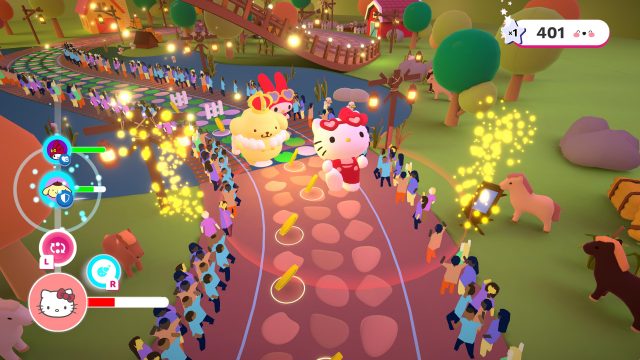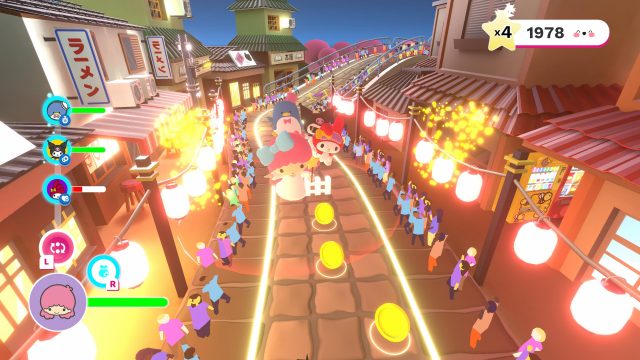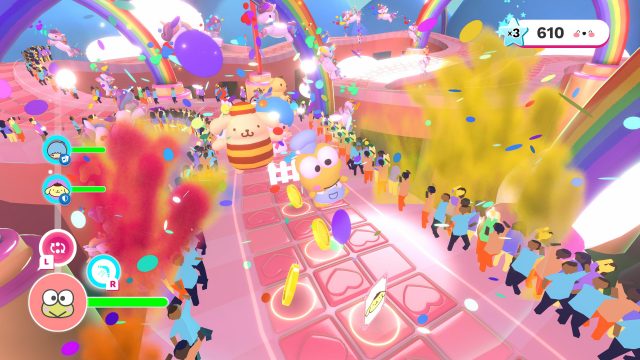Simple but fun gameplay for kids and adults; Provides a challenge for adults and an easy experience for kids thanks to the different game modes; Unlockable characters, music, character costumes, and character leveling system provide replay value; Unique character abilities keep gameplay fresh
While many tracks are catchy, most are from lesser known artists and are just ok; Characters' health meters drop too fast and negatively affect the fun; Decent graphics but could be crisper and better overall; some instances of assets vanishing; Feels like dance timing is off/laggy even after making in-game adjustments; Use of generic map locations was a lost opportunity to dance through Sanrio characters' hometowns instead; Can't replay stages right away or move backwards on the map; Can't change teammates midway through a playthrough
Sadly, Sanrio games are not typically known for being very good. As a lifelong Sanrio fan, this is disappointing; we want to have games featuring our favorite characters that are fun, well made, and enjoyable for people over 5-years-old. Given the history of these games, I went into Hello Kitty and Friends Happiness Parade with low expectations. By the time I was done playing, I put down my controller and thought, “That was actually much better than I expected.”
Hello Kitty and Friends Happiness Parade is a rhythm game with a simple concept: tap your control stick to the beat while Hello Kitty and friends dance along a parade route. The more on-rhythm you are, the higher your score.
However, this game has a bit of a learning curve that makes the game a little less simple to pick up and play than I thought it would be. Most rhythm games have a visual feature that indicates when the player is supposed to tap a button to the beat, and while Happiness Parade does too, it wasn’t immediately obvious where it was. I was pretty sure I was tapping to the beat but was just guessing, especially because I wasn’t familiar with any songs on the track list and was noticing that I wasn’t scoring so well. I finally noticed the visual cue under the characters’ feet as they’re walking, which is only sort of helpful.
It wasn’t until I poked around in the options and found the audio metronome you can turn on that I really started to improve. It’s majorly helpful, and you can adjust how loud the metronome is if it’s too distracting over the music. I started doing much better once I was going off of audio rather than visual cues.
I think part of the reason for that is because there’s so much going on on-screen than just Hello Kitty and friends marching to a beat. In addition to tapping on-rhythm, you also have to navigate the crew through obstacles laid out in the road, from fences to “minions” throwing bananas, mystery liquids, holes, and more. There are also valuable collectibles to pick up along the way, including coins, character cards, hearts, and more.
Each character has their own unique ability, and you start the game with three characters unlocked right away: Hello Kitty, My Melody, and Pompompurin. Hello Kitty can befriend the minions, which seems to provide a points bonus for every new friend she makes; My Melody can turn all the coins on the path into hearts; and Pompompurin can become invulnerable to damage for a short time. Each ability has a cooldown period that can be shortened and an effect that can last for a longer period of time with every character level increase. Leveling up requires both a certain (and gradually increasing) number of character cards and coins.
In total, eight additional characters can be unlocked other than the initial three that are available to play with: Bad Badtz-Maru, Kuromi, Pochacco, Kerokerokeroppi (my personal favorite Sanrio character), Chococat, Tuxedo Sam, Kiki, and Lala. Each character also has a set of clothing and accessories that you can buy. As soon as I had enough coins, I bought Pochacco his classic “P” tee.
This game is surprisingly challenging for being obviously aimed at a very young crowd and I think that’s pretty great. The basic setup is that, after choosing a team of three, you must traverse a map with diverging paths to play through different levels, with the goal to reach the end of the path and unlock one of the game’s five different endings. Some levels are where you’ll find the rest of the Sanrio crew waiting to be unlocked, which usually requires hitting a certain score on that stage. However, as you move deeper through the map, it becomes less simple to unlock characters; Pochacco, for example, required earning a certain number of points once, while Chococat required earning a higher number of points twice.
That means going back and replaying the stage twice. One of the frustrating things about this game though is that you can’t automatically replay the stage. Once you finish, you’re forced onto the next stage and can’t move backwards. This is understandable from the perspective of the dev — they don’t want you to just blast through the game and be instantly done with it — but the inflexibility of this mechanic was a little disappointing. I was also disappointed that you can’t change out teammates midway through a playthrough, but was pleasantly surprised to find that it’s because of the game’s very NES-era tough love method of helping you improve as a player. If all three of your teammates take too much damage from obstacles on the road, it’s game over and you have to start back from the beginning of the map.
I’m fully aware that some players might despise that old school mechanic. I personally don’t mind it (I won’t pretend it’s my favorite though), and it also gives you an opportunity to start over with a new team, figure out which combination of characters is best for you, and take different paths you didn’t take in the previous playthrough. And if you’re thinking of picking up this game for a kid and worried that might be a little too hardcore for them, the game has two difficulty levels: Normal Mode and Auto Dance Mode, the latter being “for those who want to relax” because “the characters will dance for you.” You’ll just have to do the navigation on your own, but without worrying about staying on beat the whole time.
There are 40 different tracks in the game, but I wasn’t familiar with the artists or songs. That’s a letdown for a rhythm game, because it’s easier to play and get into the game when you know the music, but many of the tracks were genuinely catchy and I found myself bobbing my head to a number of them. Tracks range in difficulty, measured in one to three flame symbols, as do the stages themselves. While most stages allow you to shuffle through songs to pick the one you want to march to, some require you to play through a tough song.
Once you reach the end of the map, you’ll unlock one of the game’s five endings. I wasn’t sure what the deciding factor(s) was/were in determining which ending I got, but they’re just cute, quick little cutscenes of the characters.
Graphically speaking, Happiness Parade isn’t going to get any accolades. While it’s bright, poppy, and pretty to look at, it’s also a little rough and muddy and could be much sharper. I also noticed some vanishing assets; at the start of every stage, the camera pans down the road, which is flanked by crowds of people the entire way down, but as the camera panned chunks of the crowd would disappear from the end of the road furthest from the camera. However, the character animations are incredibly cute and there’s nothing offensively bad that makes this game unplayable or hard to enjoy. Plus, graphics are never a selling point for these Sanrio games or anything that anyone expects top-tier visuals from.
The map had a lot of generic locations that could’ve been replaced with different meaningful locations/hometowns of the characters. I thought that was a lost opportunity to play into fan service.
My biggest complaint is that I felt like the game was suffering from some lag, even after making adjustments to correct for that in options. It just felt like I needed to tap my control stick a little too soon to get a Perfect+ score (which is even better than Perfect). For a rhythm game, that’s definitely a kink that should be worked out prior to release. I also thought characters’ damage meters dropped a little too fast and that I’d suddenly be down a teammate after just a couple of hits.
But overall, I think Hello Kitty and Friends Happiness Parade was a pretty fun experience and certainly more engaging than I was expecting to have with it. While it’s got everything that would help it appeal to kids, it’s also got some actual challenge that fans of rhythm games may enjoy. Plus, all of the unlockable content and the leveling system encourage replayability, and each character’s unique abilities keep gameplay fresh rather than a monotonous tap fest.
While the game has a lot of room for improvement, it’s also the best Sanrio game I’ve played so far across a number of different platforms over the years, and a lot more thought was put into it than just “tap to the beat to march Sanrio characters down a path.” I say give it a shot and see if it’s for you, especially if you love Sanrio and have a good time with rhythm games.
Nintendojo was provided a copy of this game for review by a third party, though that does not affect our recommendation. For every review, Nintendojo uses a standard criteria.




 ShareThis
ShareThis








